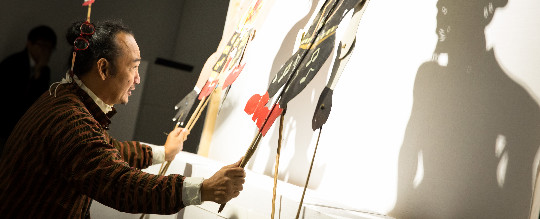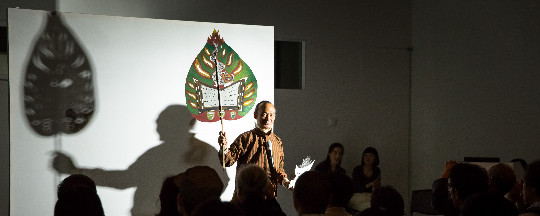SEA PROJECT Event2
Performance and Talk by Heri Dono
+ Report of the SEA PROJECT Research in Indonesia Part 1: Performance and Talk by Heri Dono


Indonesian artist Heri Dono was invited to speak at the first preview event held for SUNSHOWER: Contemporary Art from Southeast Asia 1980s to Now, the exhibition scheduled to open in the summer of 2017. Dono, whose works will be included in the exhibit, presented a performance of the Indonesian traditional wayang puppet theater, and then gave a presentation titled “Perspective of Mandala”.
Born in Jakarta in 1960, Heri Dono now stands at the forefront of Indonesia’s modern art scene. His works span a diverse range of media, including painting, illustration, and performance art. Linking traditional culture with modern sensibilities, Dono’s works have consistently and sharply critiqued governments and societies while enthralling audiences with his unique and humorous perspectives. His career began in storytelling as he used methods such as wayang and animation to tell tales. After starting his career in the 1970s, Dono was drawn to animation as a form of artistic expression. “Wayang in some way is simple animation and we actually can use the structure of wayang kulit for making cartoon films(*1),” he explains. His research into wayang led him to explore a diverse range of media, including painting and kinetic sculpture.
For the wayang performance, a white screen illuminated with spotlights was installed in the venue. Dono narrated a monologue in his native Indonesian language, accompanied by mysterious gamelan percussion music. By manipulating the puppets, changing the relative size and sharpness of the projected shadows, the comical figures of the play took on a life of their own. The story of the play centered on two artists: the impressionist Vincent van Gogh (1853-1890) and Ki Sigit Sukasman, a distinguished master of wayang. On van Gogh, Dono explained, “Van Gogh was interested in Japanese ukiyo-e woodblock prints – yet these graphic works were not only source of interest for him in Japan, but so too was Zen Buddhism. Van Gogh began to create works mimicking the techniques of wood block printing, but using the method of broken brushstrokes, In the West, he was not accepted as an artist attempting to introduce concepts of Asian spirituality. (*2)”
Sukasman, the other subject of the play, started his artistic career when he dropped out of ASRI (Academy Seni Rupa Indonesia), which is now known as ISI (The Indonesian Institute of the Arts) to study in Yogyakarta, and has since become a distinguished wayang kulit performer. “Sukasman, who lived in Europe for ten years. Sukasman introduced Art Nouveau within his works, and he also included that concept in the creation of his wayang creations. However, within Indonesia this led to him being considered as one who had destroyed tradition. Sukasman felt isolated because he was not accepted into the traditional arts, and yet neither was accepted within modern circles because he was considered to be a traditional artist,(*3)” he continued. On how he conceived his play, Dono explained, “Van Gogh and Sukasman has some similarities in their journey of art-making and the ironic elements of their biographies.” and “I am bringing the two of them together through this wayang story. In my show, they enter the cartoon world. In this wayang story, I narrate how they met and they painted sunflowers together. Both of them tried to commit suicide, but failed. Sukasman used chakra weaponsm whereas van Gogh used a pistol firearm. They tried to kill themselves again by exchanging weapons. This time round, it was successful. In the supernatural world, dead van Gogh turned into Mickey Mouse, and Sukasman turned into a wayang puppet. In the puppet world, everything is possible. (*4)”
After the performance, a peek behind the screen revealed that the puppets used to project monochromatic shadows for the audience are actually vividly-painted works of art in themselves; their existence in this other world behind the screen is startling. The traditional perspective of wayang holds that this colorful, hidden world behind the screen can only be perceived in black-and-white by those that exist in our world. Wayang performers breathe life into their puppets, manipulating them while also voicing their lines, but in Dono’s work, the puppets are moved by electric motors and combined with lighting and sound effects, incorporating aspects of his kinetic sculptures and the figures that appear in his illustrations. His particular style comes into focus if you survey his paintings and view them in sequence. Not unlike kami-shibai, a Japanese storytelling method that uses a series of pictures, these singular images come together to tell a story.
In the second half of the program, a presentation by Dono titled “Perspective of Mandala” used the example of the Borobudur Temple Compounds in Indonesia as an exploration of an East-West combined worldview arising from comparisons between the two sets of cultures. The concept of existence as borrowed space and time, one strongly prevalent in many Asian cultures, is also an underlying theme of the pluralistic culture of Indonesia, which is comprised of a multiplicity of languages, and a myriad of islands and tribes. This diversity is also evident in Dono’s low-tech installations that make use of recycled materials. He summarized his in-depth presentation with some comments on a work of his titled Voyage Trokomod, a giant tank that dominated Indonesia’s exhibit space at the 56th Venice Biennale held in 2015. Please come and explore the “SUNSHOWER” exhibition opening in summer 2017. Heri Dono’s humorous narrative works will reveal his interpretation of life in modern society and his worldview encompassing both Eastern and Western perspectives.
*1. Jim Supangkat, “Context,” in Heri Dono: Danving demons and Drunken Deities, ed. Yasuko Furuichi (Tokyo: The Japan Foudation Asia Center, 2000), 101.
*2. Heri Dono, WAYANG LEGENDA “Vincent van Gogh and Sukasman,” (Handout received at the “Performance and Talk by Heri Dono, National Arts Center, Tokyo, Sept. 24, 2016).
*3. Ibid. Heri Dono.
*4. Ibid. Heri Dono.
Photo: Shinichiro Mikuriya
Photo Courtesy: Mori Art Museum
